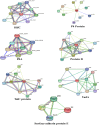Molecular insights into pangenome localization and constructs design for Hemophilus influenza vaccine
- PMID: 40594015
- PMCID: PMC12217137
- DOI: 10.1038/s41598-025-03536-0
Molecular insights into pangenome localization and constructs design for Hemophilus influenza vaccine
Abstract
Haemophilus influenza, a major contributor to respiratory infections such as pneumonia, meningitis, sinusitis, chronic bronchitis, and acute otitis, poses a significant public health challenge, driven by rising antibiotic resistance particularly among the non-typeable H. influenza (NTHi) strains given their ability to evade immune surveillance. To address this, we employed a comprehensive immunoinformatics pipeline integrated with extensive pan-genome analysis of 59 strains of H. influenzae to design a novel multiepitope vaccine (MEV) candidate targeting most virulent and clinically significant proteins. Key surface exposed and virulence associated proteins, including Protein E, PilA, Protein D, P4, TolC, YadA, and HifC were prioritized based on their roles in bacterial adhesion, immune evasion, biofilm formation, and nutrient acquisition. Advanced in silico epitope prediction and verification strategies were utilized to map highly immunogenic regions across these proteins, followed by codon optimization to enhance expression efficiency in human systems. To further stabilize the vaccine construct, we performed disulfide engineering to enhance structural integrity and resilience. Comprehensive validation through in silico immune simulations, molecular dynamics (MD) simulations and binding free energy calculations confirmed the structural stability, immunogenic potential, and strong receptor affinity of the MEV candidate. Phylogenetic and virulence factor analysis further corroborated the broad coverage of the pathogenic relevance of the selected proteins. Together, our integrative approach presents a robust pipeline for rational vaccine design, offering a promising avenue toward combating multidrug resistant and immune evasive H. influenza strains.
Keywords: Haemophilus influenza; Immune simulations; Immunoinformatics; Molecular dynamics simulations; Multi-epitope vaccine.
© 2025. The Author(s).
Conflict of interest statement
Declarations. Competing interests: The authors declare no competing interests. Author information: These authors contributed equally: Naila Zaman and Kainat Gul.
Figures











Similar articles
-
Immunoinformatics-Based development of a Multi-Epitope vaccine candidate targeting coinfection by Klebsiella pneumoniae and Acinetobacter baumannii.BMC Infect Dis. 2025 Jul 3;25(1):894. doi: 10.1186/s12879-025-11242-5. BMC Infect Dis. 2025. PMID: 40610881 Free PMC article.
-
Haemophilus influenzae oral vaccination for preventing acute exacerbations of chronic bronchitis and chronic obstructive pulmonary disease.Cochrane Database Syst Rev. 2017 Jun 19;6(6):CD010010. doi: 10.1002/14651858.CD010010.pub3. Cochrane Database Syst Rev. 2017. PMID: 28626902 Free PMC article.
-
Unleashing the future of cancer immunotherapy: in silico design of a multi-epitope and mRNA vaccine duo targeting EWSR1-ATF1, EWSR1-CREB1, and PRAME to conquer clear cell sarcoma using immunoinformatics approaches.Med Oncol. 2025 Jun 28;42(8):295. doi: 10.1007/s12032-025-02863-6. Med Oncol. 2025. PMID: 40581703
-
Development of a candidate mRNA vaccine based on Multi-Peptide targeting VP4 of rotavirus A: an immunoinformatics and molecular dynamics approach.Sci Rep. 2025 Jul 2;15(1):22610. doi: 10.1038/s41598-025-07433-4. Sci Rep. 2025. PMID: 40594603 Free PMC article.
-
Vaccines for preventing influenza in the elderly.Cochrane Database Syst Rev. 2018 Feb 1;2(2):CD004876. doi: 10.1002/14651858.CD004876.pub4. Cochrane Database Syst Rev. 2018. PMID: 29388197 Free PMC article.
References
-
- Watt, J. P. et al. Burden of disease caused by Haemophilus influenzae type B in children younger than 5 years: global estimates. Lancet374, 903–911 (2009). - PubMed
-
- The evidence for non-. typeable Haemophilus influenzae as a causative agent of childhood pneumonia | Pneumonia | Full Text. https://pneumonia.biomedcentral.com/articles/10.1186/s41479-017-0033-2 - DOI - PMC - PubMed
-
- Tsang, R. S. W. & Ulanova, M. The changing epidemiology of invasive Haemophilus influenzae disease: emergence and global presence of serotype a strains that May require a new vaccine for control. Vaccine35, 4270–4275 (2017). - PubMed
MeSH terms
Substances
LinkOut - more resources
Full Text Sources
Medical

